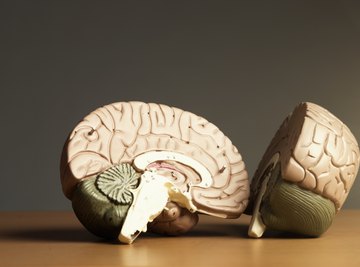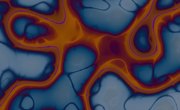
Brain cells are a type of neuron, or nerve cell. There are also various types of brain cells. But all neurons are cells, and all cells in organisms that have nervous systems share a number of characteristics. In fact, all cells, regardless of whether they are single-celled bacteria or human beings, have a few features in common.
One essential characteristic of all cells is that they have a double plasma membrane, called the cell membrane, surrounding the entire cell. Another is that they have a cytoplasm on the interior of the membrane, forming the bulk of the cell mass. A third is that they have ribosomes, protein-like structures that synthesize all proteins made by the cell. A fourth is that they include genetic material in the form of DNA.
Cell membranes, as noted, consist of a double plasma membrane. The "double" comes from the fact that the cell membrane is also said to consist of a phospholipid bilayer, with "bi-" being a prefix meaning "two." This bilipid membrane, as it is also sometimes called, has a number of key functions in addition to protecting the cell as a whole.
Cell Basics
All organisms consist of cells. As noted, the number of cells an organism has varies widely from species to species, and some microbes include only a single cell. Either way, cells are the building blocks of life in the sense that they are the smallest individual units in living things that boast all of the properties associated with life, e.g., metabolism, reproduction and so on.
All organisms can be divided into prokaryotes and eukaryotes. Pr*okaryotes* are almost all unicellular and include the many varieties of bacteria populating the planet. Eukaryotes are almost all multicellular and have cells with a number of specialized features that prokaryotic cells lack.
All cells, as mentioned, have ribosomes, a cell membrane, DNA (deoxyribonucleic acid) and cytoplasm, a gel-like medium inside cells in which reactions can occur and particles can move.
Eukaryotic cells have their DNA enclosed within a nucleus, which is surrounded by a phospholipid bilayer of its own called the nuclear envelope.
They also contain organelles, which are structures bound by a double plasma membrane like the cell membrane itself and tasked with specialized functions. For example, mitochondria are responsible for carrying out aerobic respiration within cells in the presence of oxygen.
The Cell Membrane
It is easiest to understand the structure of the cell membrane if you imagine viewing it on cross-section. This perspective allows you to "see" both of the opposed plasma membranes of the bilayer, the space in between them, and the materials which inevitably have to pass into or out of the cell through the membrane by some means.
The individual molecules that make up most of the cell membrane are called glycophospholipids, or, more often, just phospholipids. These are made of compact, phosphate "heads" that are hydrophilic ("water-seeking") and point toward the exterior of the membrane on each side, and a pair of long fatty acids that are hydrophobic ("water-fearing") and face each other. This arrangement means that these heads face the exterior of the cell on one side and the cytoplasm on the other.
The phosphate and fatty acids in each molecule are joined by a glycerol region, just as a triglyceride (dietary fat) consists of fatty acids joined to glycerol. The phosphate portions often have additional components on the surface, and other proteins and carbohydrates dot the cell membrane as well; these will be described soon.
- The lipid layer on the interior is the only true double layer in the cell membrane mix, because here, there are two consecutive membrane sections consisting almost solely of lipid tails. One set of tails from the phospholipids on one half of the bilayer, and one set of tails from the phospholipids on the other half of the bilayer.
Lipid Bilayer Functions
One lipid bilayer function, almost by definition, is to protect the cell from threats from the outside. The membrane is semi-permeable, meaning that some substances can pass through while others are denied entry or exit outright.
Small molecules, such as water and oxygen, can diffuse easily through the membrane. Other molecules, notably those that carry an electric charge (i.e., ions), nucleic acids (DNA or its relative, ribonucleic acid or RNA) and sugars can also pass, but require the help of membrane transport proteins in order for this to occur.
These transport proteins are specialized, meaning that they are designed to shepherd only a specific type of molecule through the barrier. This often requires an input of energy in the form of ATP (adenosine triphosphate). When the molecules must be moved against a stronger concentration gradient, even more ATP than usual is needed.
Additional Components of the Bilayer
Most of the non-phospholipid molecules in the cell membrane are transmembrane proteins. These structures span both layers of the bilayer (hence "transmembrane"). Many of these are transport proteins, which in some cases form a channel big enough for the specific molecule encountered to pass through.
Other transmembrane proteins include receptors, which send signals to the cell interior in response to activation by molecules on the outside of the cell; enzymes, which participate in chemical reactions; and anchors, which physically link components outside the cell with those in the cytoplasm.
Cell Membrane Transport
Without a way to move substances into and out of the cell, the cell would rapidly run out of energy and also be unable to expel metabolic waste products. Both scenarios, of course, are incompatible with life.
The effectiveness of membrane transport is dependent upon three main factors: the permeability of the membrane, the concentration difference of a given molecule between the inside and the outside, and the size and charge (if any) of the molecule under consideration.
Passive transport (simple diffusion) depends only on the latter two factors, as molecules that enter or exit cells by this means can easily slip through the gaps between phospholipids. Because they carry no charge, they will tend to flow inward or outward until the concentration is the same on both sides of the bilayer.
In facilitated diffusion, the same principles apply, but membrane proteins are required to create enough space for the uncharged molecules to flow through the membrane down their concentration gradient. These proteins can be activated either by the mere presence of the molecule "knocking at the door" or by changes in their voltage triggered by the arrival of a new molecule.
In active transport, energy is always required because the movement of the molecule is against its concentration or electrochemical gradient. While ATP is the most common energy source for transmembrane transport proteins, light energy and electrochemical energy can also be used.
The Blood-Brain Barrier
The brain is a special organ, and as such it is specially protected. This means that in addition to the mechanisms described, brain cells have a means of more tightly controlling the entry of substances, which is essential for maintaining whatever concentration of hormones, water and nutrients is needed at a given time. This scheme is called the blood-brain barrier.
This is largely accomplished thanks to the way the small blood vessels entering the brain are constructed. The individual blood vessel cells, called endothelial cells, are packed unusually close together, forming what are known as tight junctions. Only under certain conditions are most molecules granted passage between these endothelial cells in the brain.
References
About the Author
Kevin Beck holds a bachelor's degree in physics with minors in math and chemistry from the University of Vermont. Formerly with ScienceBlogs.com and the editor of "Run Strong," he has written for Runner's World, Men's Fitness, Competitor, and a variety of other publications. More about Kevin and links to his professional work can be found at www.kemibe.com.
